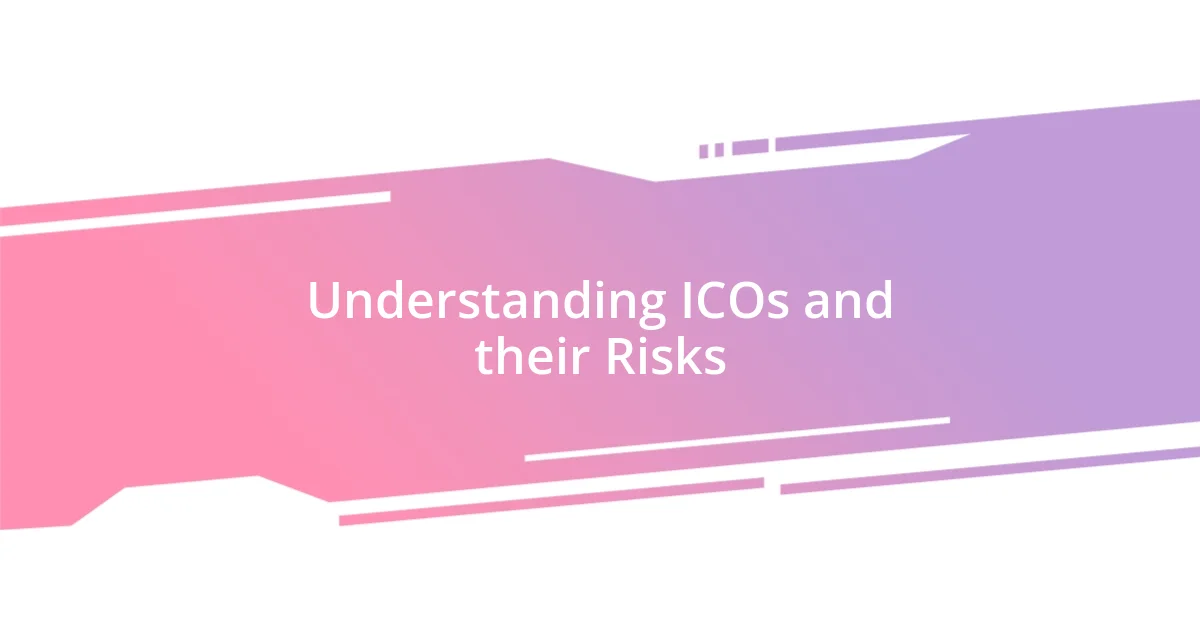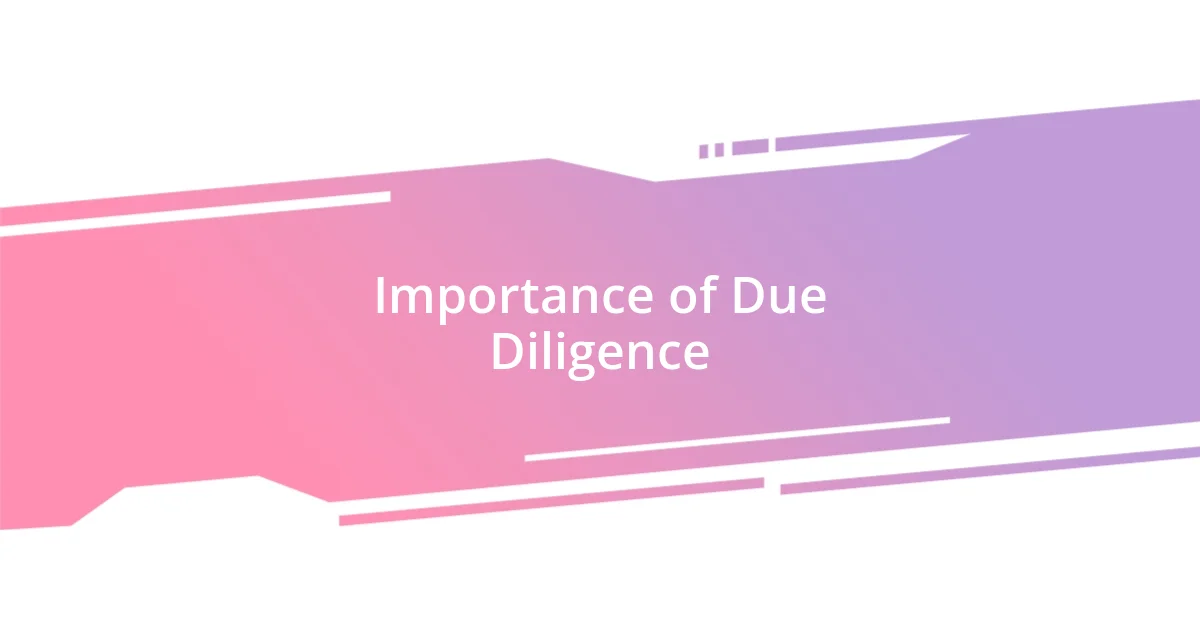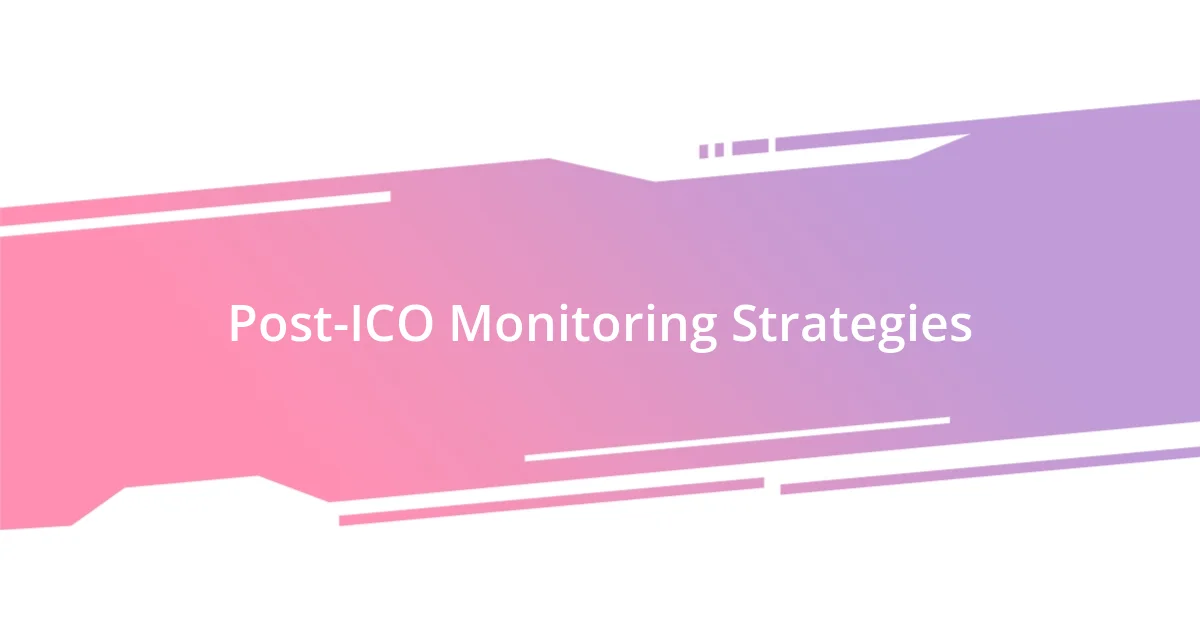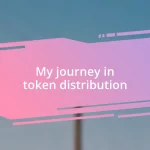Key takeaways:
- ICOs pose significant risks including lack of regulation, market volatility, and potential for fraud, making thorough due diligence essential.
- Key areas to evaluate include team experience, white paper clarity, community engagement, regulatory compliance, and market demand.
- Post-ICO monitoring is crucial; staying informed through community feedback and tracking token performance can help assess ongoing project viability.

Understanding ICOs and their Risks
ICOs, or Initial Coin Offerings, are a popular way for startups to raise funds by selling digital tokens. Personally, I remember the excitement I felt during the early days of ICOs; it seemed like a gold rush. However, that initial thrill quickly turned to caution as I learned about the multitude of risks involved.
One major risk is the lack of regulation. Since ICOs often fall outside the purview of traditional financial oversight, investors can find themselves exposed to fraud and scams. Have you ever considered how easy it is for someone to create a seemingly legitimate project but then vanish overnight? In my experience, digging deeper into a project’s team and roadmap has often revealed red flags that were not immediately obvious.
Market volatility is another area of concern. The value of tokens can fluctuate dramatically, which can lead to significant financial loss. I remember being part of a community that celebrated a token soaring, only to watch it plummet days later. It reinforced a crucial lesson for me: understanding what drives token value is essential for making informed decisions.

Importance of Due Diligence
Due diligence is vital when considering an ICO. It’s not just about reading the white paper; it’s about diving deeper into all aspects of a project. I recall a project that seemed promising initially, but through due diligence, I uncovered discrepancies in their team’s qualifications and a vague timeline that raised my concerns significantly.
Understanding the importance of comprehensive research cannot be understated. In many cases, what you see on the surface may mask underlying issues. I’ve often found myself in conversations where fellow investors expressed regret over not verifying information before investing. It’s that careful attention to detail and willingness to question what’s presented that can save one from potential financial pitfalls.
In today’s environment, where scams are rampant, incorporating due diligence into your investment strategy isn’t just smart—it’s essential. I’ve witnessed firsthand how thorough research transformed my outlook on a project that initially felt stable but, upon deeper analysis, had major warning signs. The emotional toll of financial loss is immense, and that’s why I advocate for diligent investigation before jumping into any ICO.
| Due Diligence Benefits | Consequences of Ignoring |
|---|---|
| Informed Decision-Making | Potential Financial Loss |
| Increased Confidence in Investments | Exposure to Scams |
| Identification of Red Flags | Long-term Regret |

Key Areas to Evaluate
When evaluating an ICO, I find it crucial to focus on specific areas that can reveal the project’s true potential. One aspect I always delve into is the team behind the project. I’ve come across situations where a project’s success was significantly overstated because the team lacked real-world experience in the industry. Knowing the founders, their backgrounds, and their previous achievements can often provide a clearer picture of the project’s credibility.
Here are key areas to evaluate in any ICO:
- Team Experience: Assess the skills and backgrounds of team members; a robust team is often a good indicator of success.
- White Paper: Analyze the white paper’s clarity and feasibility; a well-structured document should clearly outline the vision and implementation plan.
- Community Engagement: Look for active community discussions; a vibrant community reflects interest and support for the project.
- Regulatory Compliance: Check if the ICO adheres to local regulations; compliance is a safety net against potential legal issues.
- Tokenomics: Examine how the tokens will be distributed and utilized; a sustainable economic model is crucial for long-term viability.
Personal experience taught me the importance of scrutinizing the roadmap. In one case, a project I was excited about provided a seemingly detailed plan. However, as I tracked its progress, I noticed significant delays and unexplained changes that left me uneasy. It’s those subtle shifts that often signal deeper issues lurking beneath the surface. Being proactive and asking questions can turn the tide in your favor.

Analyzing Whitepapers Effectively
When I first started analyzing whitepapers, I often felt overwhelmed by the jargon and technical details. However, I quickly learned that focusing on the core components can make a significant difference. Does the whitepaper clearly articulate the problem it aims to solve? If I can’t identify a real-world issue that resonates with me, that’s a definite red flag.
I remember one particular whitepaper that looked impressive at first glance. But as I dug deeper, I found inconsistencies in their proposed solutions. They claimed to have a revolutionary technology, yet the explanation was filled with vague terminology. This experience taught me the importance of seeking clarity. If a whitepaper doesn’t foster understanding, how can I trust the project’s vision?
Engaging with the project’s vision is vital. I always ask myself: does this project inspire excitement, or does it raise suspicion? During one analysis, I found a project that almost seemed too good to be true. But by systematically evaluating its whitepaper, I discovered several logical leaps that left me questioning its feasibility. That’s why I now approach each whitepaper not just as a document, but as a conversation; it should communicate its intent clearly, and if it doesn’t, I think twice about moving forward.

Evaluating the Team Behind ICO
One thing I’ve learned over time is that the credibility of an ICO often hinges on the expertise and integrity of its team. For instance, I once invested in an ICO where the founders touted impressive academic credentials. However, as I dug a little deeper, I realized none of them had actually worked in the blockchain space before. This experience left me questioning how they could successfully navigate the complex landscape of crypto.
I mean, isn’t it alarming when you find a project team that has a great résumé but lacks relevant experience? I recall another ICO where the team had hands-on industry experience and a proven track record. Their prior work gave me confidence that they had the ability to tackle challenges head-on. When I saw their genuine commitment to the development of the project, it felt reassuring. It’s those tangible experiences that often speak louder than fancy degrees.
Moreover, I always check how transparent the team is about their identities and their roles. In one instance, I backed a project that initially seemed promising, but the team was shrouded in mystery. After some digging, I learned they were unwilling to reveal much about their past endeavors. This lack of transparency raised a red flag for me; true innovators should be open about their journey. It makes me wonder: if a team is hesitant to share their background, what else might they be hiding?

Assessing Market Demand
Assessing market demand is a critical step in evaluating an ICO, and I often turn to community sentiment for insights. Platforms like Telegram and Reddit can provide a wealth of information, often reflecting genuine excitement or skepticism about the project. I distinctly remember a time when early discussions about an ICO revealed a split opinion among potential investors; that honestly made me pause and consider whether the project had the broader appeal it claimed.
I’ve found that looking beyond social media to analyze search trends and competitor landscape can also uncover valuable insights. When I assessed an ICO that boasted innovative technology, I noticed a noticeable lack of interest in existing forums and search queries. This pattern made me wonder—if no one is searching for this solution, is there truly a market need? Such observations have led me to trust my instincts and dig deeper into demand metrics rather than just relying on flashy marketing.
When it comes down to it, understanding market demand isn’t just about raw data; it’s about gauging real user interest and potential adoption. During one analysis, I reached out to industry experts who provided candid feedback and unique perspectives on the project’s viability. Their insights spurred my curiosity—why was there hesitation when the team claimed to have a breakthrough design? By engaging with the community and experts, I realized that market demand is often a subtle dance of perceptions, trends, and genuine excitement.

Post-ICO Monitoring Strategies
Post-ICO monitoring is essential for ensuring that an investment remains viable. Personally, I find it crucial to regularly check in on project updates and developments. Last year, I followed an ICO that promised groundbreaking technology, and I made it a point to keep an eye on their progress reports. When the team missed several key milestones without any communication, I started to feel a knot in my stomach—was this a red flag, or was I overreacting? It turned out to be the former, as they eventually faded into obscurity.
I also believe in the power of community engagement during this phase. After one ICO I invested in launched its platform, I immersed myself in user forums. I vividly remember reading a mixture of excitement and concerns from early adopters regarding usability issues. Those candid conversations opened my eyes to potential problems; it made me realize that community feedback is often a goldmine for gauging the health of a project post-ICO. How many times have we relied solely on an official update when there’s an entire ecosystem of voices sharing their experiences?
Another strategy I employ is tracking token performance on exchanges. There was a time when I invested in a token that initially skyrocketed, but I noticed a significant drop in trading volume shortly after. This decline left me pondering—was this a temporary dip, or were investors starting to lose faith? By diving into trading analytics, I discovered that many were selling off due to concerns over the project’s roadmap. That experience taught me the importance of not just watching the price but understanding the underlying sentiment driving it.














